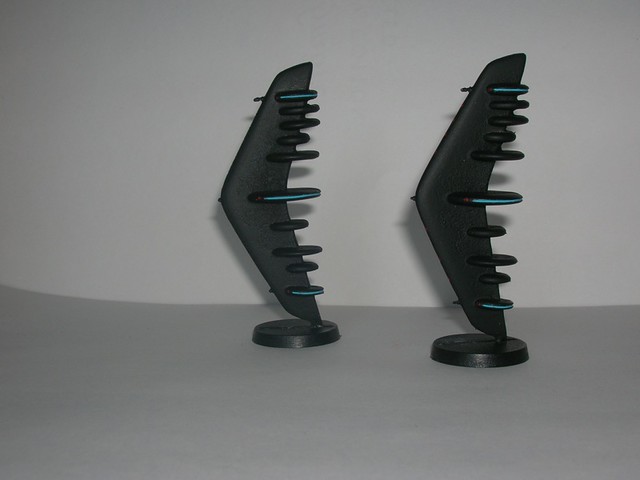Two of us met and gamed a Narn-Shadow meeting engagement.
Pictures up on flickr or you can view them as a slide show turn by turn.
Here is the description:
2 scouts
1 G'Lan cruiser
2 T'Loth Assault Cruisers
1 Dag'Kar Missile Frigate
1 Ka'Toc Battle Destroyer
1 Sho'Kar Light Scout Cruiser
Shadows won initiative and the Narns started setting up first.
The G'Lan cruiser, Dag'Kar Missile Frigate, Ka'Toc Battle Destroyer held back while the T'Loths, Bin'Tak and the scout advanced.
The Shadows advanced at max on all fronts. However, the two scouts were
out of range and saw no action this turn. One Shadow cruiser
concentrated its fire on the vanguard T'Loth, while the other attacked
the Bin'Tak. Both Narn ships took significant damage. The Bin'Tak
remained in the battle, but the T'Loth was immobilized and one crew
point shy of having a skeleton crew.
The vanguard T'Loth attacked the closest Shadow scout, but wasn't able
to destroy the scout. The Bin'Tak and Dag'Kar loosed the energy mines
and other long range armament, but aside from damaging the scout
closest to the vanguard T'Loth, the Shadows took little damage.
The Narn scout reduced the stealth on a scout, but didn't much damage.
Turn 2
One Shadow cruiser attempted to move into a flanking position on the
Bin'Tak, while the other moved to engage the undamaged T'Loth and
G'Lan. The damaged scout flanked the immobile T'Loth. The other scout
played chicken with the Narn scout and ended up getting hit in the
rear, but no damage result owing to the Shadow scout's shields.
The G'Lan cruiser, and the mobile T'Loth moved up next to the ailing
T'Loth as did the Ka'Toc Battle Destroyer. The Dag'Kar Missile Frigate
held back while the Bin'Tak rotated in place to engage the Shadow
cruiser. Both traded blows with one another, with the Shadow cruiser
received scratches while the Bin'Tak took it on the chin, but still
focused it fire.
The damaged Shadow scout finally dispatched the immobile T'Loth while
the other Shadow cruiser concentrated on the G'Lan and gave it quite a
bruising including critical hits that left it immobilized.
The Dag'Kar and Ka'Toc attacked the Shadow scouts, but did not take either down.
The Narn fighters did engage the Shadow fighters, but with the local
advantage in numbers, the Shadows prevailed in the two dogfights.
Amazingly, a Shadow scout was able to avoid significant damage from a
cloud of Narn fighters.
Turn 3
One Shadow cruiser continued its attempt to flank the Bin'Tak, and
positioned itself just to the side of the Bin'Tak and out of range. The
other Shadow cruiser continued to engage the G'Lan.
The Shadow damaged scout turned its attention on the Ka'Toc and was
able to reduce it to a skeleton crew in the first shot. The other scout
focused its attentions on the G'Lan.
The Dag'Kar Missile Frigate, its energy mines fully loaded, attacked
the Shadow scout attacking the G'Lan. The Narn scout sailed behind the
Shadow ships. The remaining T'Loth contemplated opening a jump gate
next turn.
Over all, while the scenario was balanced points wise, the Shadows were
able to out maneuver the Narns and were well on their way to winning
the day. Both players felt that the Narns needed more ships to balance
the game out better.


